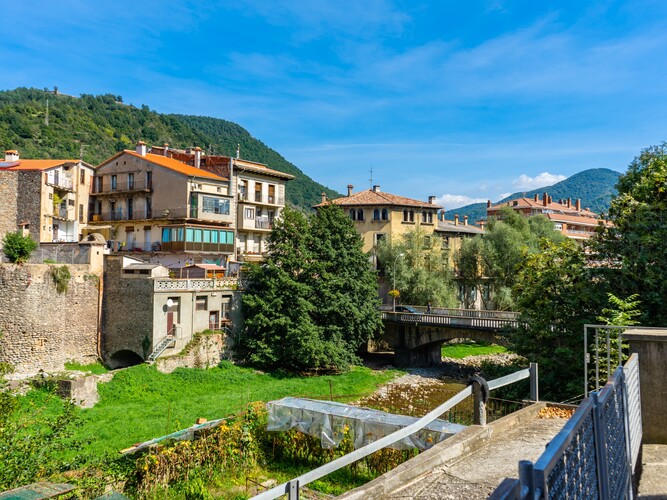The Costa Brava is packed year after year with partying young people and camping families. But Catalonia is more than sun, sea and beach. Leave your swimgear at home and jump on a bike to explore the versatile hinterland. Cycling through Catalonia can be a lot of fun!
With views of the snow-capped peaks of the Pyrenees or the lush hills that hide the craters of volcanoes. Past farms, rivers, through villages, hamlets and provincial towns, across fields, past pear orchards, through pine forests and then ending with a dip in the sea along the rugged coast of Spain. In the northeastern province of Girona, cycling is very attractive thanks to the so-called Vías Verdes.
Cycling around Ripoll
The mountain town of Ripoll has a pleasant atmosphere. In the background you can see the peaks of the Pyrenees. The main attraction here is the ninth-century Benedictine monastery Monestir de Santa María. A group of German holiday cyclists – well tanned and in cycling outfits – are enjoying an undoubtedly well-deserved lunch on the square in front of the monastery building. Their racing bikes are temporarily shining in the bright sun.
Also read: Spain is a hiking paradise
Vías Verdes
Ripoll is the starting point of the Vías Verdes, or the ‘Green Paths’. The cycling and walking routes were constructed along the old railway lines that used to run through the Catalan province of Girona. Viaducts and tunnels on the route are still reminders of this. The very first kilometres on the route – from Ripoll to Sant Joan de les Abadesses and Ogassa – together form the Ruta del Ferro i Carbó, the old steel and coal route. In the past, there were many iron forges in this area and coal was extracted in the mines of Ogassa, a village in the area. Time to hit the road.

Along the way, several villages, farms and an old station appear. There is hardly any oncoming traffic. Furthermore, there are many views over exclusively green valleys and mountains. The Ter and the Freser also have their source here in the valleys of Núria and Campodron. From the path you can take a trip to the origin of these rivers. The first part of the route proves relatively easy without a steep climb or descent. Remarkably, we hardly encounter any other cyclists or walkers along the way. An additional advantage of a visit to the hinterland.
Medieval village
The old railway line to the mines has not been used since 1967. The last kilometres to Ogassa turn out to be a steep climb. If you don’t like this, you can also choose to skip the mining village. The railway line between Ripoll and the typical Catalan mountain village of Sant Joan operated until 1980. Do you have time for a stopover? Then visit this medieval village with its thirteenth-century monastery and Romanesque bridge.
Cycling around Olot
The road continues towards Olot, the capital of the La Garrotxa volcanic area. The least difficult road, over the asphalted GI-521, turns out to be quite a climb to reach the highest point, the Coll de Sentigosa at an altitude of 1064 metres. Fortunately, the road is hardly used by cars and the views are spectacular. Moreover, after the climb up, a refreshing descent towards Olot awaits.
Volcanic landscape
Olot is located in the middle of the Parc Natural de la Zona Volcànica. The city has traditionally attracted many artists because of its landscape. Their work can be viewed in the many galleries in Olot. Also very worthwhile: the modernist route along the buildings that the so-called Indians had built. These Catalans made their fortune in Cuba at the end of the nineteenth century and returned home with their pockets full.
The second Vía Verde is the Ruta del Carrilet between Olot and the provincial capital Girona, by far the most popular cycling route in all of Catalonia. The path initially runs straight through the volcanic area, which is very densely vegetated due to the fertile soil. The unknowing passer-by would not even notice that dozens of volcanoes are hidden here. In most cases, the fire eaters simply appear to be wooded hills.
Nature as the highlight
The route continues past around ten villages with various sights including churches and modernist buildings and mainly rural architecture. But the real highlight is and remains nature. Through the vast corn fields, over gently sloping hills – the Pyrenees are now far behind us – and through the dense forests with deciduous trees. Along the rivers Fluvià, Ter and Burguent. Here and there a sports cyclist or walker passes by on the 54 kilometre route, but usually the peace and quiet predominates.



